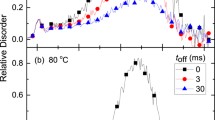Abstract
The properties of point defects are of major concern in the interpretation and application of irradiation effects in solids. To this end, diffusion studies provide valuable understanding and information. A central tool is the high specific-activity radiotracer, itself a product of nuclear research. This paper reviews the development of our understanding of atomic migration phenomena, starting from the period just after World War II, when radiotracers became generally available. Application of these techniques, along with developments in other fields, soon provided detailed thermodynamic and dynamic information about microscopic point defect processes. In the cases of such simple metals as the pure noble metals, we now have convincing models of mechanism, along with quantitative values of such parameters as activation enthalpies and entropies, correlation factors, activation volumes, and the energetics of interactions with solute ions and with other defects. For other systems, such as the bcc metals, tracer studies have provided a wealth of knowledge and have revealed a rich range of phenomena, many of which have not yet been unambiguously explained.
Similar content being viewed by others
References
P. Shewmon:Diffusion in Solids, McGraw-Hill, New York, NY, 1963, p. 203.
L. Girifalco:Atomic Migration in Crystals, Blaisdell, New York, NY, 1964, p. 162.
Y. Adda and J. Philibert:La Diffusion dans les Solides, Presses Universitaires de France, Paris, 1966, vols. 1-2, p. 1268.
J. Manning:Diffusion Kinetics for Atoms in Crystals, Van Nostrand, Princeton, NJ, 1968.
N. Peterson:Diffusion in Metals inSol. State Phys., F. Seitz, D. Turnbull, and H. Ehrenreich, eds., Academic Press, New York, NY, 1968, vol. 22, pp. 409–512.
C.P. Flynn:Point Defects and Diffusion, Clarendon Press, Oxford, 1972.
R. Borg and G. Dienes:Introduction to Solid State Diffusion, Academic Press, Orlando, FL, 1988.
Diffusion, H. Aronson, ed., ASM, Metals Park, OH, 1973.
Diffusion in Solids—Recent Developments, A. Nowick and J. Burton, eds., Academic Press, Orlando, FL, 1975.
Dimeta-82: Diffusion in Metals and Alloys, F. Kedves and D. Beke, eds., Trans Tech Publications Ltd., Aedermannsdorf, SO, Switzerland, 1983.
Diffusion in Solids in Materials Science Forum, A. Laskar, G. Tiwari, E. Subbarao, and R. Krishnan, eds., Trans Tech Pub- lications Ltd., Aedermannsdorf, SO, Switzerland, 1984, vol. 1.
Diffusion in Crystalline Solids, G. Murch and A. Nowick, eds., Academic Press, Orlando, FL, 1984.
W. Johnson:Trans. AIME, 1941, vol. 143-47 p. 197; 1942, vol. 147, pp. 331-46.
L. Darken:Trans. AIME, 1948, vol. 175, pp. 184–93.
A. Smigelskas and E. Kirkendall:Trans. AIME, 1947, vol. 171, pp. 130–34.
L. Correa da Silva and R. Mehl:J. Met., 1951, vol. 191, pp. 155–73.
F. Seitz:Phys. Rev., 1948, vol. 74, pp. 1513–23; Acta Crystall., 1950, vol. 3, pp. 355-63.
H. Huntington and F. Seitz:Phys. Rev., 1949, vol. 76, p. 1728; 1953, vol. 91, pp. 1092-98.
C. Wert:Phys. Rev., 1950, vol. 79, pp. 601–05; J. Appl. Phys., 1950, vol. 21, pp. 1196-97.
C. Zener:J. Appl. Phys., 1951, vol. 22, pp. 372–75.
A. Nowick:J. Appl. Phys., 1951, vol. 22, pp. 1182–86.
J. Bardeen and C. Herring:Diffusion in Alloys inImperfections in Nearly Perfect Crystals, W. Shockley, J. Hollomon, R. Maurer, and F. Seitz, eds., John Wiley & Sons, New York, NY, 1952; pp. 261–88.
A. Schoen:Phys. Rev. Lett., 1958, vol. 1, pp. 138–40 and 184.
S. Rothman and N. Peterson:Phys. Rev., 1967, vol. 154, pp. 552–58.
D. Lazarus:Phys. Rev., 1954, vol. 93, pp. 973–76.
A. LeClaire:Phil. Mag., 1962, vol. 7, pp. 141–67.
Author information
Authors and Affiliations
Additional information
This paper is based on a presentation made in the symposium “Irradiation-Enhanced Materials Science and Engineering” presented as part of the ASM INTERNATIONAL 75th Anniversary celebration at the 1988 World Materials Congress in Chicago, IL, September 25-29, 1988, under the auspices of the Nuclear Materials Committee of TMS-AIME and ASM-MSD.
Rights and permissions
About this article
Cite this article
Slifkin, L. Tracer diffusion. Metall Trans A 20, 2577–2582 (1989). https://doi.org/10.1007/BF02670151
Issue Date:
DOI: https://doi.org/10.1007/BF02670151




